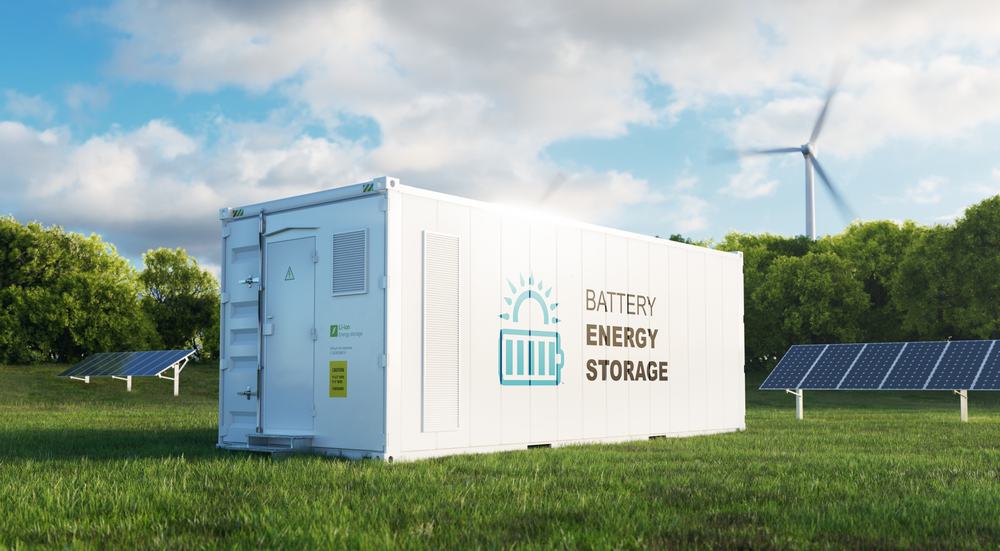
High-capacity battery energy storage system in a container
In a battery energy storage system (BESS), electrical energy is stored in batteries for later use. In times of low demand or when renewable energy sources such as solar and wind aren’t generating power, a BESS can store excess electricity and discharge that stored energy when demand is high.
Typical Battery Energy Storage System Components
A BESS consists of several key components that work together to store electrical energy, manage its flow, and provide grid support services like frequency regulation and backup power. BESS configurations and components depend on the system’s intended application, size, and location. The table below lists the typical battery energy storage system components.
|
Battery Energy Storage System Components |
|
|
Battery Cells or Modules |
Fundamental units that store electrical energy using various chemistries like lithium-ion or lead-acid. |
|
A system that manages and monitors battery cells, ensuring safe operation and maximizing performance. |
|
|
Inverter/Converter |
A device that converts direct current (DC) electricity from batteries into alternating current (AC) that can be used in electrical systems. |
|
Power Conditioning System |
A system for conditioning power output according to certain requirements, such as regulating voltage and frequency. |
|
Cooling and Thermal Management System |
A system that enhances the lifespan and efficiency of batteries by keeping them at optimal operating temperatures. |
|
Enclosure and Housing |
Physical protection for batteries and associated electronics, often including safety features. |
|
Safety Systems |
Fire suppression systems, overcurrent protection, thermal runaway prevention for safe operation, and other safety systems. |
|
Monitoring and Control Systems |
Real-time performance monitoring systems that enable remote control and automation. |
|
Energy Management System |
A system that manages operations based on factors such as demand response signals, electricity prices, and weather forecasts. |
|
Grid Connection Equipment |
Transformers, switchgear, and protective devices needed to connect the BESS to the electrical grid. |
|
Auxiliary Power Supply |
Power for critical functions such as control and monitoring to ensure that operations continue even when the power is out. |
BESS Advantages and Disadvantages
BESSs are essential for modernizing and optimizing electricity systems as they improve reliability, provide flexibility, and facilitate the integration of renewable sources. However, there can be high-capital costs and other disadvantages for some applications. Here is a list of BESS advantages and disadvantages:
|
BATTERY ENERGY STORAGE SYSTEM |
|
|
Advantages |
Disadvantages |
|
➕Reduces peak loads on the grid by discharging stored energy during times of high electricity demand. |
➖High initial capital cost, particularly for large-scale installations. |
|
➕Balances supply and demand on the grid, improving overall system stability. |
➖Batteries degrade over time with use, leading to a reduction in capacity and performance. |
|
➕Responds to fluctuations in grid frequency, providing ancillary services like frequency regulation to help maintain grid stability. |
➖Lithium-ion batteries can pose safety risks such as overheating, fire, or explosion if not properly managed or maintained. |
|
➕Provides backup power to critical infrastructure, homes, and businesses, ensuring continuity of operations. |
➖Production, use, and disposal of batteries can have environmental consequences, including resource depletion and pollution. |
|
➕Stores excess energy generated from renewable sources when production exceeds demand and discharges stored energy when renewable generation is low. |
➖A BESS incurs energy losses during charging and discharging cycles, reducing overall system efficiency. |
|
➕Integrates into electric vehicle charging stations to manage demand spikes and provide fast-charging capabilities without overloading the grid. |
➖Regulatory barriers or uncertainty regarding grid interconnection, market participation, and revenue streams can hinder the deployment of BESS. |
Ongoing advancements in battery technology, declining costs, and supportive policies are driving increased adoption of BESSs worldwide as a critical component of modern energy systems.
BESS Components and CAD Software
BESS components can be designed using CAD software, which enables engineers to create detailed 3D models of each component, facilitating visualization, analysis, and simulation. CAD models aid in designing, manufacturing, and integrating BESS components into larger energy systems.
If you’re looking for CAD models for common components or parts and important information for battery energy storage system components implementation, Ultra Librarian helps by compiling all your sourcing and CAD information in one place.
Working with Ultra Librarian sets up your team for success to ensure streamlined and error-free design, production, and sourcing. Register today for free.








